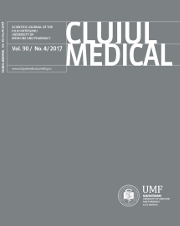Infantile hemangiomas: a 7-year experience of a single-center
DOI:
https://doi.org/10.15386/cjmed-781Keywords:
infantile hemangioma, risk factors, treatment, evolutionAbstract
Objectives. The aim of the study was to describe the historical and clinical characteristics of hemangiomas in a series of cases of our clinic.
Methods. This is a retrospective study of 36 patients with infantile hemangiomas consulted in our clinic.
Results. We had 14 multiple hemangiomas, and 1 kaposiform hemangioendothelioma. Almost two-thirds involved the cephalic extremity, and 76% of the cases were treated. Pregnancy risk factors included prematurity, low-birth weight and respiratory distress syndrome. Propranolol was used in 22 cases, followed by prednisone in 3 cases. Vincristine and interferon were used as associated therapies or as second line therapies. Two hemangiomas had complications, one ulceration and a Kasabach-Merritt syndrome. All the patients had a good evolution.
Conclusions. Our study results regarding the involvement of pregnancy and birth risk factors in developing infantile hemangiomas is similar to literature data. The majority of patients had at least one risk factor suggesting that at least one trigger to develop an infantile hemangioma is necessary. Our study shows that the cephalic extremity is mostly involved, and because of its potential complications they are most likely to be treated. The study shows that propranolol is the leading treatment option with few and mild side effects.
Downloads
Published
How to Cite
Issue
Section
License
The authors are required to transfer the copyright of the published paper to the journal. This is done by agreeing to sign the Copyright Assignment Form. Whenever the case, authors are also required to send permissions to reproduce material (such as illustrations) from the copyright holder.

The papers published in the journal are licensed under a Creative Commons Attribution-NonCommercial-NoDerivatives 4.0 International License.

